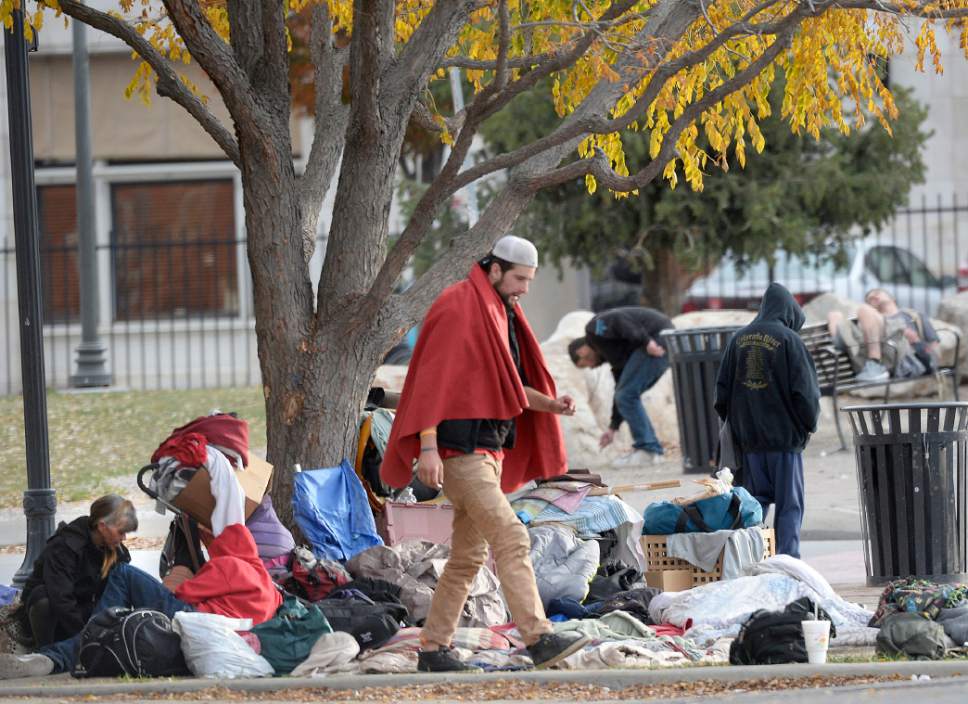This is an archived article that was published on sltrib.com in 2017, and information in the article may be outdated. It is provided only for personal research purposes and may not be reprinted.
State officials asked legislative budget-writers on Monday to give top funding priority to reducing homelessness in Salt Lake City, while some city residents asked them to block money for a controversial planned new shelter in Sugar House.
Lt. Gov. Spencer Cox, who heads a state homeless coordinating committee, asked for $3.5 million this year to help Salt Lake City build four new homeless resource centers to help replace the large The Road Home shelter, and other efforts to eliminate barriers to those seeking crisis housing.
He said the money represents some of the state's share of partnering with the city, Salt Lake County and private donors. "We're all working together to solve the puzzle of homelessness in our state."
Jon Pierpont, executive director of the Utah Department of Workforce Services, said that should be enough to help start work on two of four new resource centers over the next 18 months.
"Potential funding will be used to diffuse the mass humanity and safety concerns now experienced down at the Rio Grande" area around The Road Home shelter, he said. "Decentralizing housing crisis services will increase safety, decease impact on the surrounding communities and directly influence the quality of services received."
But numerous residents asked appropriators to stop any funds for a proposed shelter at 653 E. Simpson Ave in Sugar House.
They said it is too near residential areas, would increase crime, is too expensive and wastes money that could be better spent elsewhere.
"Our property values have already fallen dramatically," said landowner Robert Breeze. He said they will fall more "when the neighborhood suffers from drug dealing, prostitution and violence," which he contends the shelter could attract. His solution: a single shelter site on the west side of the city, surrounded by a secure perimeter fence.
George Chapman, a former mayoral candidate, said the city spending of $7 million to buy the controversial site would have been better spent on giving housing vouchers to families with children to keep them out of shelters.
Sen. Brian Shiozawa, R-Cottonwood Heights, was among legislators who said he favors giving funding priority to homelessness problems, but warned that it appears officials still have much to resolve with neighbors of the Sugar House site.
Reps. Rebecca Chavez-Houck and Angela Romero, both Salt Lake City Democrats, were critical of Monday's objections to 653 E. Simpson Ave. during an exchange on Twitter.
"NIMBY at its best," Romero wrote.
"My favorite proposal was to fence in the homeless in a Westside SLC compound," wrote Chavez-Houck. "Wow."
Cox and Rep. Becky Edwards, R-North Salt Lake, also requested another $4 million for new affordable housing programs to help families avoid homelessness. It would help fund tax credits to encourage development of new affordable housing, and for a fund to guarantee rent payments by low-income people.
A state report last month said the number of Utah's extremely low-income families now exceeds the rental units they can afford by more than 38,000 — equivalent to the population of Kearns.
"This is the tightest rental market we have had in my 40 years of experience" of studying housing in Utah, James Wood, with the Kem Gardner Institute at the University of Utah, told appropriators.
Edwards is separately pushing HB36 to authorize the new programs. It passed the House on a 50-22 vote, and passed a preliminary vote in the Senate 26-3.
Edwards said she and her husband spent two years on a service mission for The Church of Jesus Christ of Latter-day Saints at Salt Lake County's Oxbow Jail, helping inmates who were transitioning to the community.
"Seeing those issues, real-time, with these people that we had known in a church setting and really grown fond of ... and seeing the barriers that were there for them in their unique circumstances, it was rough, and it gave me a different perspective," she said.
She "ran out of time" on affordable housing legislation in the last general session, Edwards said, but a state task force spun out of her efforts. The nearly three dozen community leaders examined the data and found that the housing shortage extends beyond urban boundaries.
"It's Beaver County, it's Carbon, it's Daggett," Edwards said. "Every single county has significant need in that affordable housing sector."





